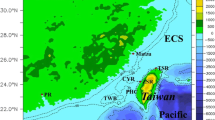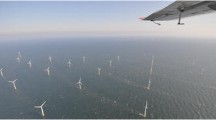Abstract
The Humber Estuary, UK, divides into the Ouse and Trent estuaries at the so-called Apex within its upper reaches. Remotely sensed Compact Airborne Spectrographic Imager (CASI) images and boat measurements were used to observe a strong turbidity maximum in the upper Humber and Ouse during a spring tide in November 1995. Surface suspended particulate matter (SPM) concentrations during the late ebb, as estimated from the CASI data, increased from approximately 6 to 13 g I−1 moving up-estuary into the Ouse. Greater SPM concentrations (∼10 g I−1) were evident in the deeper channels of the Ouse, compared with shallower areas, possibly due to faster ebb currents there and differential down-estuary advection of the turbidity maximum. Ribbons, or streaks, of lower SPM and slightly cooler waters were observed. It appears that slightly cooler and lower turbidity waters from the confluent Trent estuary remained fairly distinct for distances of approximately 2 km down-stream of its confluence with the upper Humber and Ouse. These waters eventually broke into ribbon-like or streak-like structures within the higher SPM-laden and slightly warmer waters of the Humber. They were discernible for more than 5 km down-estuary of the confluence of the Humber, Ouse, and Trent. Boat measurements showed that the turbidity maximum occurred over a fairly restricted region of the upper Humber, between about 20 to 50 km from the tidal limit at high water. The turbidity maximum’s sediment load was largely suspended in the water column during stronger currents. SPM rapidly settled close to the bed during high water and low water slack periods. At these times, SPM concentrations in a thin, near-bed layer were >60 g I−1 in the turbidity maximum region of the Ouse and >30 g 1−1 in the upper Humber (where channel volumes were much greater). SPM within the turbidity maximum comprised very fine-grained material and its low organic content demonstrated that the SPM was essentially mineral, clastic sediment derived originally from erosion and decay of crustal rocks.
Similar content being viewed by others
Literature Cited
Aguirre-Gomez, R. 2000. Detection of total suspended sediments in the North Sea using AVHRR and ship data.International Journal of Remote Sensing 21:1583–1596.
Allen, G. P., J. C. Salomon, P. Bassoulet, Y. Du Penhoat, andC. De Grandpre. 1980. Effects of tides on mixing and suspended sediment transport in macrotidal estuaries.Sedimentary Geology 26:69–90.
Allen, G. P., G. Sauzay, P. Castaing, andJ. M. Jouanneau. 1977. Transport and deposition of suspended sediment in the Gironde Estuary France, p. 63–81.In M. Wiley (ed.) Estuarine Processes. Academic Press, New York.
Amos, C. L. andB. J. Topliss. 1985. Discrimination of suspended particulate matter in the Bay of Fundy using the Nimbus 7 coastal Zone Color Scanner.Canadian Journal of Remote Sensing 11:85–92.
Anger, C. D., S. K. Babey, and R. J. Adamson. 1990. A new approach to imaging spectroscopy, p. 72–86.In G. Vane (ed.), Imaging Spectroscopy of the Terrestrial Environment. Proceedings of the International Society for Optical Engineering 1298. Bellingham, Washington.
Bale, A. J., C. D. Barrett, J. R. West, andK. O. K. Oduyemi. 1989. Use of in-situ laser diffraction particle sizing for particle transport studies in estuaries, p. 133–138.In J. McManus and M. Elliott (eds.) Developments in Estuarine and Coastal Study Techniques. Olsen and Olsen, Denmark.
Bale, A. J. andA. W. Morris. 1987. In-situ measurement of particle size in estuarine waters.Estuarine, Coastal and Shelf Science 24:253–263.
Dyer, K. R. 1994. Estuarine sediment transport and deposition, p. 193–218.In K. Pye (ed.), Sediment Transport and Depositional Processes. Blackwell Scientific Publications, Oxford, United Kingdom.
Festa, J. F. andD. V. Hansen. 1978. Turbidity maxima in partially mixed estuaries: A two-dimensional numerical model.Estuarine and Coastal Marine Science 7:347–359.
Geyer, W. R. 1993. The importance of suppression of turbulence by stratification on the estuarine turbidity maximum.Estuaries 16:113–125.
Geyer, W. R., R. P. Signell, andG. C. Kineke. 1998. Lateral trapping of sediment in a partially mixed estuary, p. 115–124.In J. Dronkers and M. Scheffers (eds.) Physics of Esturies and Coastal Sea. A. A. Balkema, Rotterdam.
Grabemann, I. andG. Krause. 1989. Transport processes of suspended matter derived from time-series in a tidal estuary.Journal of Geophysical Research 94:14373–14379.
Hooker, S. B., W. E. Esaias, G. C. Feldman, W. W. Gregg, andC. R. McClain. 1992. An overview of SeaWiFS and ocean color. NASA Technical Memorandum 104566. NASA, Greenbelt, Maryland.
Jay, D. A., W. R. Geyer, R. J. Uncles, J. Vallino, J. Largier, andW. R. Boynton. 1997. A review of recent developments in estuarine scalar flux estimation.Estuaries 20:262–280.
Jørgensen, P. V. andK. Edelvang. 2000. CASI data utilized for mapping suspended matter concentrations in sediment plumes and verification of a 2-D hydrodynamic model.International Journal of Remote Sensing 21:2247–2258.
Le Hir, P. andB. Thouvenin. 1994. Mathematical modelling of cohesive sediment and particulate contaminants transport in the Loire Estuary, p. 71–79.In K. R. Dver and R. J. Orth, (eds.), Changes in Fluxes in Estuaries. Olsen and Olsen, Fredensborg.
Li, Z. H., K. D. Nguyen, J.-C. Brun-Cottan, andJ.-M. Martin. 1994. Numerican simulation of the turbidity maximum transport in the Gironde Estuary (France).Oceanologica Acta 17: 479–500.
Matthews, A. M., A. G. Duncan, andR. G. Davison 2001. Error assessment of validation techniques for estimating suspended particulate matter concentration from airborne multispectral imagery.International Journal of Remote Sensing 22: 449–469.
McCave, I. N. 1979. Suspended sediment, p. 131–185.In K. R. Dyer (ed.), Estuarine Hydrography and Sedimentation. Cambridge University Press, Cambridge, United Kingdom.
Milliman, J. D. andJ. P. M. Syvitski. 1992. Geomorphic/tectonic control of sediment discharge to the ocean: The importance of small mountainous rivers.Journal of Geology 100:525–544.
Mitchell, S. B., J. R. West, A. M. W. Arundalf, I. Guymer, andJ. S. Couperthwaite. 1998. Dynamics of the turbidity maxima in the upper Humber estuary system, UK.Marine Pollution Bulletin 37:190–205.
Mockridge, W., M. Leach, andA. K. Wilson. 1997. Integrating a Daedalus 1268 ATM, attitude GPS and AHRS to achieve scan rate geometric correction, p. H58-H65.In N. Wallman (ed.), Proceedings of the Third International Airborne Remote Sensing Conference and Exhibition, 7–10 July 1997, Copenhagen, Denmark. Environmental Research Institute of Michigan, Ann Arbor, Michigan.
Morel, A. andL. Prieur. 1977. Analysis of variations in ocean colour.Limnology and Oceanography 22:709–722.
Natural Environment Research Council. 1994. Implementation Plan for a Community Research Project. Land-Ocean Interaction Study. Natural Environment Research Council Publication, Swindon, United Kingdom.
Newson, M. D. 1986. River basin engineering fluvial geomorphology.Institution of Water Engineers and Scientists 40:307–324.
Nichols, M. M. 1972. Sediments of the James River Estuary Virginia,Geological Society of America Memoir 133:169–210.
Nimmo Smith, W. A. M., S. A. Thorpe, andA. Graham. 1999. Surface effects of bottom-generated turbulence in a shallow tidal sea.Nature 400:251–253.
Officer, C. B. 1981. Physical dynamics of estuarine suspended sediments.Marine Geology 40:1–14.
Officer, C. B. andM. M. Nichols. 1980. Box-model application to a study of suspended-sediment distributions and fluxes in partially mixed estuaries, p. 329–340.In V. Kennedy (ed.), Estuarine Perspectives. Academic Press, New York.
Robinson, M.-C., K. P. Morris, andK. R. Dyer. 1998. Deriving fluxes of suspended particulate matter in the Humber Estuary, UK, using airborne remote sensing.Marine Pollution Bulletin 37:155–163.
Stebbing, A. R. D., D. Huntley, andG. J. L. Leers. 1998. Integrated riverine, estuarine and coastal research in the UK Land-Ocean Interaction Study (LOIS).Marine Pollution Bulletin 37:115–121.
Switski, J. P. M., M. D. Morehead, D. Bahr, andT. Mulder. 2000. Estimating fluvial sediment transport: The rating parameters.Water Resource Research 36:2747–2760.
Uncles, R. J., A. E. Easton, M. L. Griffiths, C. Harris, R. J. M. Howland, I. R. Joint, R. S. King, A. W. Morris, andD. H. Plummer. 1998a. Concentrations of suspended chlorophyll in the tidal Yorshire Ouse and Humber Estuary.The Science of the Total Environment 210/211:367–375.
Uncles, R. J., A. E. Easton, M. L. Griffiths, C. Harris, R. J. M. Howland, R. S. King, A. W. Morris, andD. H. Plummer. 1998c. Seasonality of the turbidity maximum in the Humber-Ouse Estuary, UK.Marine Pollution Bulletin 37:206–215.
Uncles, R. J., P. E. Frickers, A. E. Easton, M. L. Griffiths, C. Harris, R. J. M. Howland, R. S. King, A. W. Morris, D. H. Plummer, andA. D. Tappin. 2000. Concentrations of suspended particulate organic carbon in the tidal Yorkshire Ouse River and Humber Estuary.The Science of the Total Environment 251/252:233–242.
Uncles, R. J. andJ. A. Stephens. 1993. Nature of the turbidity maximum in the Tamar Estuary, UK.Estuarine, Coastal and Shelf Science 36:413–431.
Uncles, R. J., J. A. Stephens, andC. Harris. 1998b. Seasonal variability of subtidal and intertidal sediment distributions in a muddy, macrotidal estuary: The Humber-Ouse, UK, p. 139: 211–219.In K. S. Black, D. M. Paterson, and A. Cramp (eds.), Sedimentary Processes in the Intertidal Zone. Geological Society, London.
van Leussen, W. 1994. Estuarine Macroflocs and Their Role in Fine-grained Sediment Transport. Cip-Gegevens Koninklijke Bibliotheek, Den Haag, The Netherlands.
Wilkinson, W. B., G. J. L. Leeks, A. W. Morris, andD. E. Walling. 1997. Rivers and coastal research in the Land Ocean Interaction Study.The Science of the Total Environment 194/195:5–14.
Wilson, A. K. 1997. An integrated data system for airborne remote sensing.International Journal of Remote Sensing 18:1889–1901.
Wilson, A. K., W. Mockridge, andM.-C. Robinson. 1997. Post-processing to achieve radiometric and geometric correction of ATM and CASI data, p. I447-I454.In N. Wallman (ed.), Proceedings of the Third International Airborne Remote Sensing Conference and Exhibition, 7–10 July 1997, Copenhagen, Denmark. Environmental Research Institute of Michigan, Ann Arbor, Michigan.
Wolanski, E., B. King, andD. Galloway. 1995. Dynamics of the turbidity maximum in the Fly River Estuary, Papua New Guinea.Estuarine, Coastal and Shelf Science 40:321–337.
Wolanski, E., N. N. Huan, Le Trong Dao, N. N. Nhan, andN. N. Thuy. 1996. Fine-sediment dynamics in the Mekong River Estuary, Vietnam.Estuarine, Coastal and Shelf Science 43:565–582.
Source of Unpublished Materials
Switski, J. P. M. Personal Communication. Director, Institute of Arctic and Alpine Research, University of Colorado at Boulder, 1560 30 th Street, Campus Box 450, Boulder, Colorado 80309-0450.
Author information
Authors and Affiliations
Corresponding author
Rights and permissions
About this article
Cite this article
Uncles, R.J., Lavender, S.J. & Stephens, J.A. Remotely sensed observations of the turbidity maximum in the highly turbid Humber Estuary, UK. Estuaries 24, 745–755 (2001). https://doi.org/10.2307/1352882
Received:
Accepted:
Issue Date:
DOI: https://doi.org/10.2307/1352882




